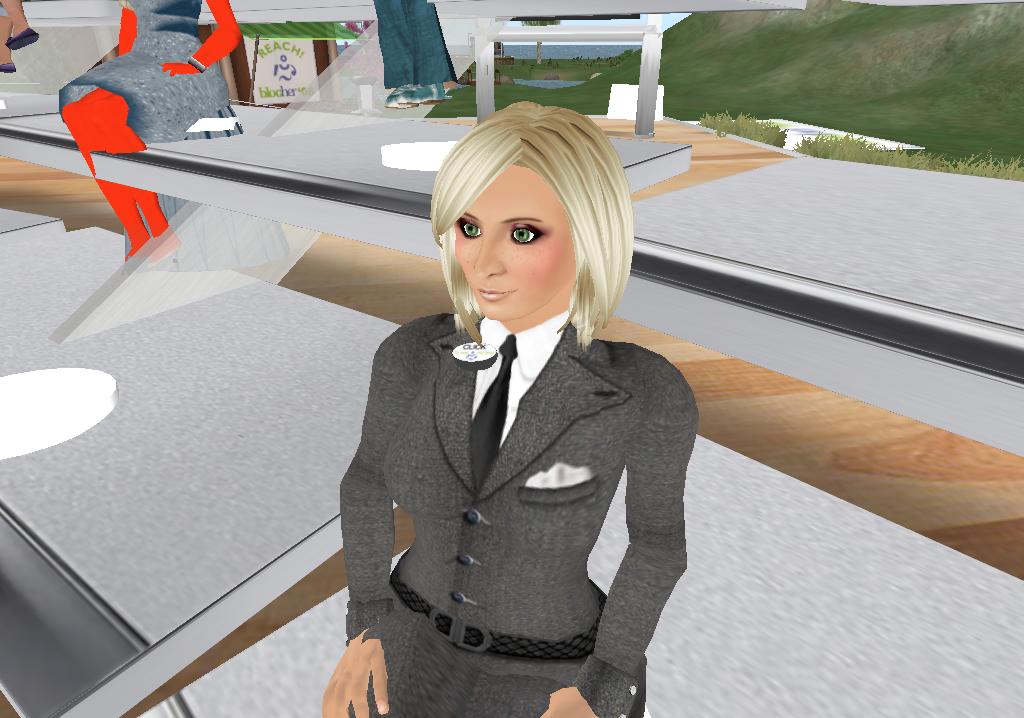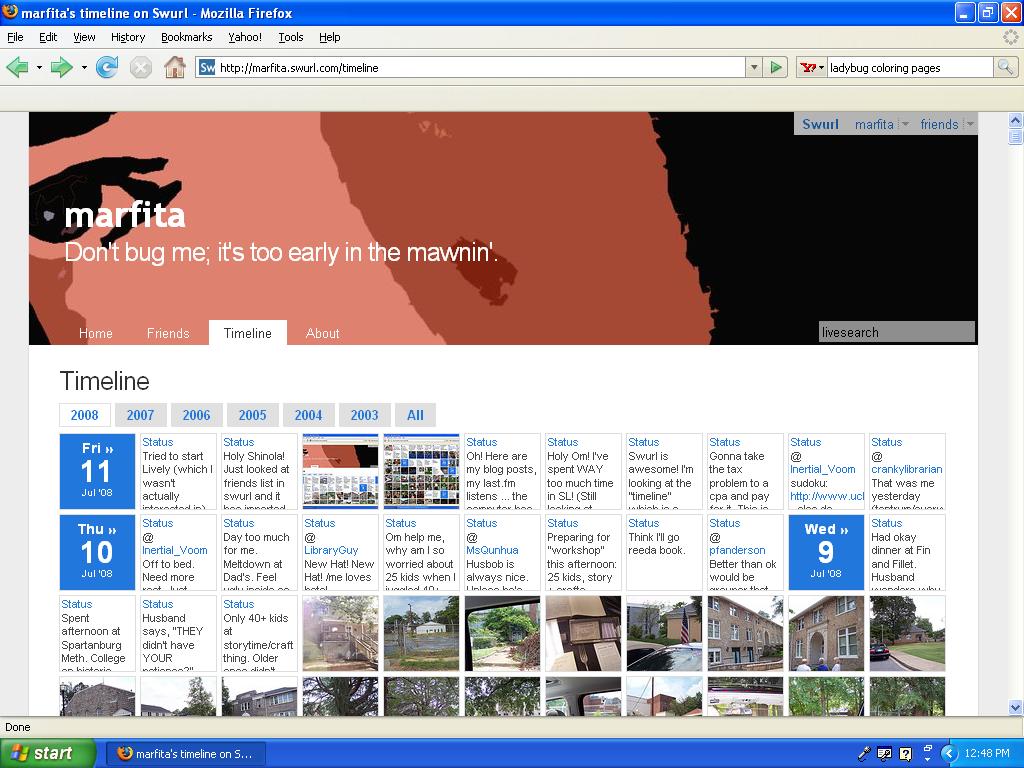
Again, if my notes here are too much for you, the podcast for this portion of the summit is
here. I don't blame you at all - it's taking me three, no,
four days to transcribe my notes!
Anastasia Goodstein came back at us in the afternoon, tonsils blazing. I don't know how she does it. The topic was the same, but skewed to the Tweens age group.
We are immigrants and they were born into this internet/tech world. They work intuitively (banging away until it works). We might delicately consult a manual [yeah, I
used to do that - now I just bang away]. We might dig for more information and they don't bother. "Privacy Settings? What are those?" They don't look for settings to tweak.
1. Phone.
35% of Tweens own a cell phone because they want what their older siblings have and they get it because parents are afraid since 9/11 and want to be in contact. There are companies and services just for Tweens, with parental controls, such as the
Firefly Phone. They view the phone as an extension of themselves, as a new kind of watch or alarm clock.
2. Computer/Internet
They use them for games, memory games. The digital divide still exists, but it has narrowed. It's a good thing to have some blocking for younger kids and Tweens, but keep the social sites open.
3. Portable Gaming Device
Tweens are still looking at their parents for cues. The desire to stay connected with friends is strong and universal. We had our landline friends after school. They text and call their crushes continuously. IM is more important to Tweens than Teens.
They're into WebKins Mail and MySpace (yeah, they aren't supposed to be on this, but they are). They use e-mail to communicate with adults. Tween e-mail addresses and handles are often wildly inappropriate (hotchicksexy44). Make sure they fix those handles if they want to communicate with adults for babysitting jobs, teachers, etc.
Gosh, do they ever talk to each other in person? Yes, but texting is just as meaningful. And it's easier to share digitally, can say more, can say things you can't say to a face.
Younger kids are online, but not as much as we think. Heavens, they're even reading books! Girls and multi-cultural types more likely to be reading non-textbooks.
They time is more planned out, less time to hang out and be kids.
More than 1/4 of age 13 kids have social site profiles. There's a law that companies/sites can't save info on users age 13 and under. Easy to lie about one's age and create multiple profiles. They want what the older kids have.
They're on MySpace and message boards.
Beinggirl.com - a commerical Tampax site - hang out and chat!
Virtual Worlds: There has been an explosion in the population here. 100+ live or in beta. Some are independent communities and some are commercial, such as: Disney, Nickelodeon, other tv-related virtual worlds (half of the most popular sites are these),
Lego,
Barbie Girls, Brats, Webkins,
Club Penguin ... and more coming because these are really effective with the tween demographic. They are playing games on them and not socializing as much as teens and adults. Same idea as our paperdolls: penguins or Barbies, you put clothes and things on them. [Same with my avatar in Second Life, but I can radically change her look to almost anything: man, dinosaur, something teensy, something huge.]
The language on these sites is filtered and often moderated. You can only use certain words. But tweens are ingenious at getting around this.
Projected population of 8 million to 20 million 2007-2011 in virtual worlds.
Being a tween is about experimenting with identity. Most tweens go online pretending to be someone else. They customize the technology to reflect their identities. Celebrities play a big role, as well as special ringtones for their phones, wallpaper, icons, and twinkly fonts. Tweens really care about the environment, and this will show up as well. [Programming idea?] They lard up their MySpace profiles, shocking our sensibilities by the way they express how they see themselves ... today. Tomorrow, I guess, they can find All New Ways to shock us.
They love to use widgets and comment on blogs. Boys mostly like to upload video. Tween boys like videos that gross out or are about falling down. Girls prefer performance videos: nailing that perfect handstand. YouTube is a favorite site; Kidsbop hosts videos as well.
Validation, Fame, and Fortune:
Tweens have a gap in their sense of privacy and what is for public consumption.
This again, is blamed on the advent of reality tv, which they grew up on and are the biggest consumers of these programs, even if they are aimed at adults. They are used to a public confessional booth, baring souls and sharing frustrations. They now have their own tools to do this themselves. We used to write our deepest feelings in a diary we kept locked; they put theirs in a blog. What they share takes our breath away.
They don't think how this will affect future employment (as babysitters or even farther in the future), but if employers start eliminating applicants based on their blog content, they will soon run out of employable applicants.
Everyone has their own person brand. They are creating media that is successful with their peers (because we are horrified).
One speaker started designing websites for her friends, next she had to
hire her friends to help her. At age 17 she was a
sponsor for Anastasia's speaking engagement.
There's a successful 15 year old podcaster. [Granted, they aren't tweens now, but they were when they started out.] These kids who are really driven are exceptions.
Validation comes swiftly, if not that coherent.
The Dark Side:
Cyberbullying is a problem. It's just so easy to be more cruel in the anonymity of being online. This happens most with middle-schoolers, just like offline bullying. They are afraid to tell their parents or other adults because they might lose their computer privileges. 30% report online bullying; 54% report offline bullying. 16% of that 30% report that someone intentionally posted something mean about them online. The only positive note is that the tools are their to block online bullies.
Tweens are entirely too trusting and share passwords. This makes it easy to flame ex-friends (dropping friends happens all the time at that age). Other tweens can get into their ex-friends' sites and spend all their virtual money or destroy their virtual weapons, etc. They can create an "Anastasia's A Slut" page; stuff like this spreads faster than offline cruelty, making it a much bigger deal.
This online cruelty between peers is a more frequent threat than predators. It's not just in the hallway anymore.
Librarians can lead the assault on this by teaching digital ethics. Teachers are overworked, having to teach to tests, the sites are blocked in schools.
Tweens are the most marketed-to generation. Anastasia is a Gen-Xer and she doesn't remember anything like this from her youth. After the clamp down on ads for sodas, cereals, and candy on tv, these have been moved to the internet sites where kids play games.
Kids are used to googling for schoolwork. They excel at finding, but not at evaluating credibility. Library databases are not keyworded the way Google is and it's harder for them to learn (so they don't bother). They don't know how to evaluate what is credible information. So, if you teach them to edit a Wikipedia article, they will learn that
any dufus can do this. You can show them Wikiscanner, and make another teachable moment.
While they can't drive real cars, they can go online and outfit a Scion on
Whyville. And, if they miss clam payments on it, their virtual car is virtually repo'd. [Cool! An important lesson!]
Ask them what sites they go to, why they go, why they are fun. There are more and more all the time. Have them show you how to do it. They will laugh at you, but will be glad to show off their expertise. You can use that for another teachable moment - asking about privacy and ethics.
Tweens are continuously text messaging. They only use e-mail with the dinosaur adults. Have to point out that IM/text messaging shortcuts are fine for that, but don't look good on an English paper. Teach them active reputation management.
Tweens are more comfortable screwing up online. [Perhaps they'll make teflon presidential candidates.] They need to know that their real names should go on thoughtful comments and intelligent blogs for future employers to find.
As librarians in the avant garde, we need to talk to the Luddites among us and stop dropping names like Pownce, Twitter, etc. [Second Life] and making them dizzy and resentful [and giving them headaches].
We should take more time to educate than to legislate.
Question period:
Question about putting out TMI (Too Much Information). Answer: Well, sometimes when you put personal stuff out, it helps someone.
Tweens as 9 to 14 year olds? Yes, they run the gamut on maturity levels. However, children under the age of 8 do not understand what advertising is - they can't recognize it.
Sharing in previous generations was keeping diaries and journals, but not really "shared" outside of that. We took photos all the time, but didn't put them up for all the world to see. Kids now will undress and take pictures of themselves. Their peers call that being a "camwhore." Pornography is becoming a part of mainstream culture. Witness the "Pussycat Dolls" [Wha-at?! I looked this
up and it's apparently some sluttier version of the Spice Girls?]. Girls like to look sexy and pose sexy. [Note: There was a photo of Shirley Temple as a child posed like Betty Grable from a 3/4 rear. This is not terribly new, but more widespread. The writer Charles Dodson (Lewis Carroll) took nude photographs of children, which was apparently common in Victorian times and allegedly innocent of sexual content.] These photos are taken for boyfriends, not the creepy pedophiles. They get out virally, though, which Anastasia finds disturbing.
Kids find ways to get access to the internet from their mobile phones,not laptops.
They need to learn to manage their online reputations, use sources appropriately, to help them get in the workforce. From celebrity culture they've learned how to virally promote themselves, a valuable skill, sought after by marketers.
There was a kid in Oregon, who was totally unpopular. He started a t-shirt company and studied what made people buy them. He figured out that kids liked cool party pictures of themselves, so he went to parties (lord knows how someone so unpopular got invited), took high quality pictures that the kids couldn't do for themselves [at this point I realized that this is, OMG!, what I do in Second Life.], and created a brand around "Pretty Ugly." Once he'd established himself and his "brand" this way, he used that to sell tees. He is now the "cool" kid.
Different carriers/agreements/plans make mobile social network difficult. Some kids are using the "
Sidekick" with friends, but not having that system cuts other kids out, creates a barrier. The cost is coming down. What kids really want is the iPhone and smartphones in general. This wave is coming. Europe and Asia already have this.
Parents get all bent out of shape over technology because they don't hear about it until the news has a story about someone getting into trouble. They don't see the value. Should have programs for parents to see what is good about the technology. It's hard to get parents to come out at night, so Anastasia points out that her book is "really easy to read - ha ha!"
After this, Charlotte-Mecklenberg had a presentation on things they have done in this area that they are proud of. They brought up the "
Boys Read" blog and then my feed got cut off. Bummer! This Digital Youth summit had a lot of great and useful information, that may have been more useful if I had been able to see the slideshows. Then again, maybe, being so busy taking notes, I may not have had the time to appreciate the slides anyway.






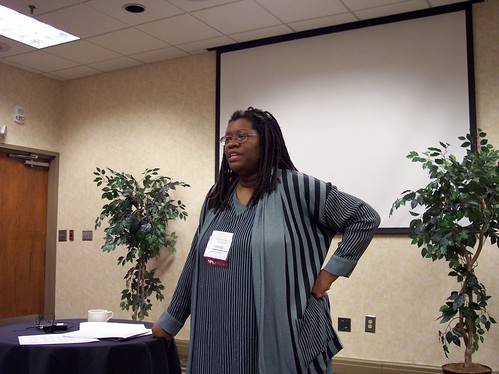

















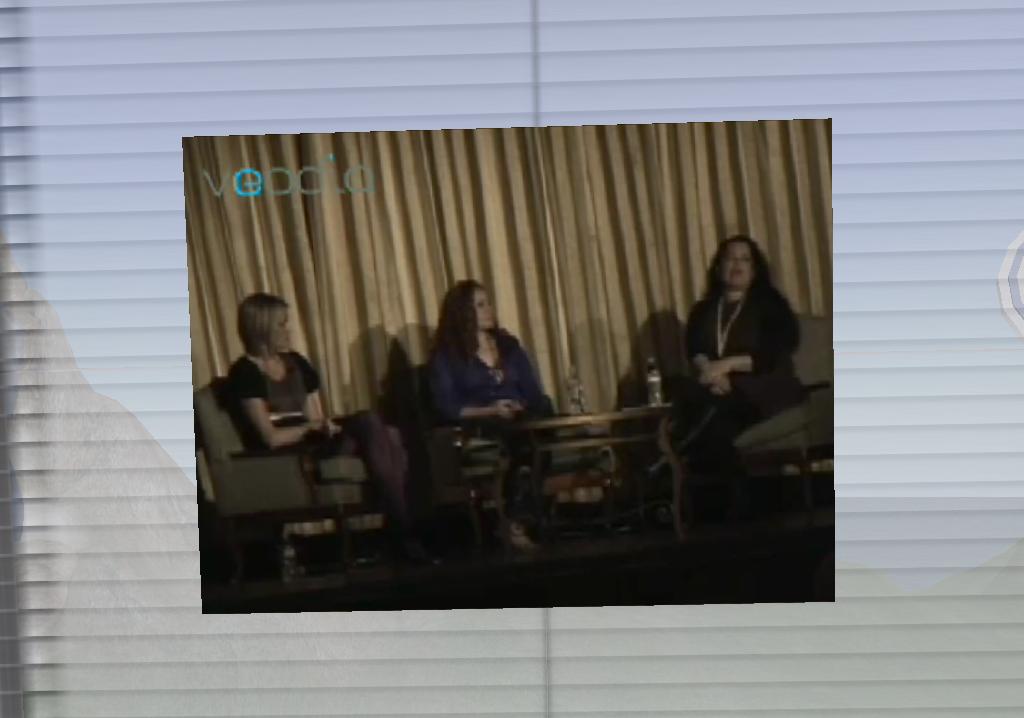
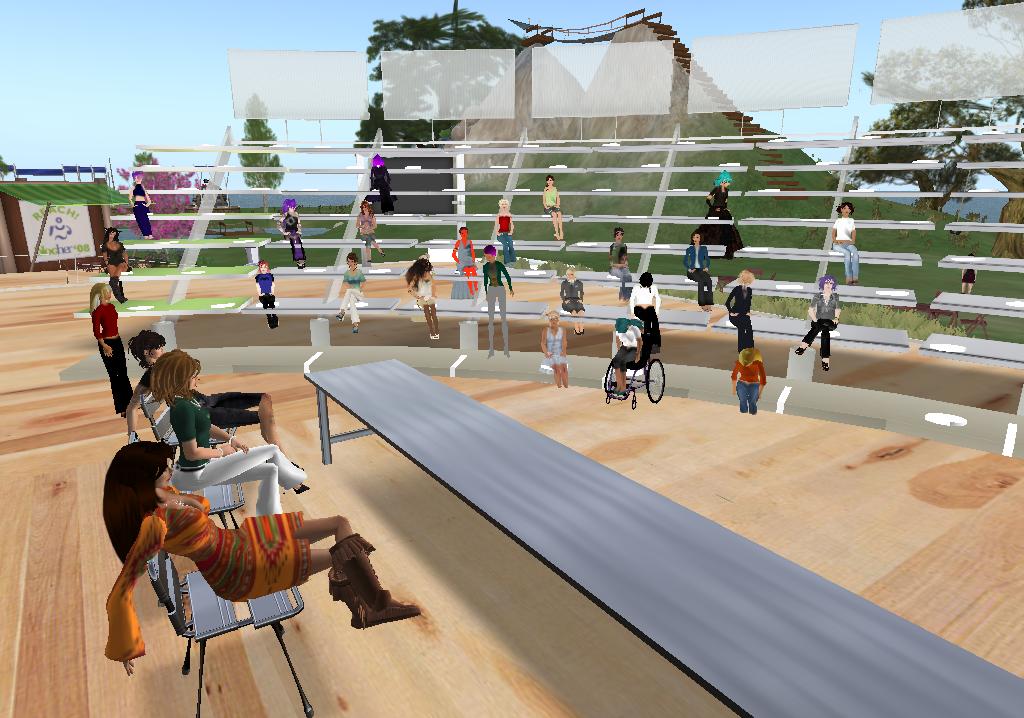 Panelists for the Blogging SL session and some of the attendees (note wheelchair accessibility).
Panelists for the Blogging SL session and some of the attendees (note wheelchair accessibility).